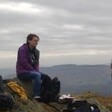Arts and Culture 25 August 2013

‘Survival’ from John Halaka’s Landscapes of Desire series. Image courtesy of the artist.
This week, I had the privilege of speaking at length with Palestinian-American artist John Halaka about his artistic development and his exhibition, Landscapes of Desire, currently showing at the Arab American National Museum in Detroit. The full interview will be running soon on The Electronic Intifada, but as usual, there was too much to fit into one feature.
So, by way of a taster, here are Halaka’s thoughts on how he believes that Americans, and especially the art scene, see Palestine. The excerpt came out of a discussion on the increasingly high profile of Palestinian art – including overtly political pieces – in European galleries.
The recent Shubbak festival in London, for instance, saw several exhibitions of work by Palestinian painters, sculptors and installation artists at both specialist Arab art institutions and even mainstream galleries such as the ICA. According to John Halaka, though, it may be a long time before American audiences have the same kind of opportunities:
I’m glad to hear that in Europe the interest is growing, because I haven’t sensed that at all in the US. There is some interest, but there are still the same – not even glass, but metal – walls, practically impenetrable for Palestinian artists. There is an interest in the idea amongst the general public, especially the progressive public.
The thing about the US is that politically progressive individuals, up until seven to ten years ago, had a very regressive, Zionist vision of the Palestinian conflict. That’s changing, so that gives me hope.
In terms of the art world, it’s not enough. There’s some. I’ve shown my work, other artists have shown their work. The Station Museum, almost ten years ago, put together a major exhibition, Made in Palestine. But those were minor in the big picture of things.
There’s never been a major exhibition of Palestinian art except for someone like Mona Hatoum. A lot of people look at her work — and I find her her work wonderful and fascinating — but they don’t make the connection with Palestine. So in the US, I don’t think the interest in Palestinian art has reached an institutional level, but it’s beginning to reach an individual level.
One of the things that I find interesting and quite hopeful is that my students are beginning to have a complex understanding of Palestine and Israel. What I mean by that is they are beginning to raise questions instead of just listening to the media.
I teach a class with a colleague on Palestinian art and literature, and I find that the students come in with little knowledge and a lot of good questions and they leave with a bit more knowledge and infinitely more questions and to me that’s really wonderful. We taught it just recently and the students were really wonderful. They thought hard, they worked hard, they read a lot and in some cases they tried to contact artists to write their research paper through direct interviews.
I think American curators and museum directors and gallery owners are cowards when it comes to political art. Anything that challenges of critiques American global policy but especially Arab world policy, they don’t deal with it, they ignore it.






Comments
check out my Levantine TV interview with John Halaka
Permalink Jordan Elgrably replied on
I interviewed John Halaka at the DIWAN conference at the AANM in April (parts 1 and 2):
http://vimeo.com/66605770
http://vimeo.com/68111595
A simple FB like is not enough
Permalink CSal replied on
Professor Halaka's comments about American curators and museum directors is on point.
At this point, it almost also seems fair to say that Arab Americans need to be more pro-active in their support to promote the work of artists like Professor Halaka.
A simple like on Facebook may not be enough. If you're a student, contact your university and make arrangements for to get local Palestinian art on display. Once the whole Arab community is on board, maybe museum curators and directors will get on board too. That goes for politics too.
Palestinians are artists, writers, musicians...
Permalink Jordan Elgrably replied on
For years Palestinians were inextricably associated with terrorists. After Oslo, (even as settlement building only continued apace) it was gratifying to see the image of Palestinians begin to improve, albeit gradually. Today it is the artists, the writers, the musicians who are humanizing the Palestinian image. At our center in L.A. we have put our shoulder to the work, to bring more Palestinian culture to the public. That continues when during the first week of October, 2013, we present "A Celebration of Palestinian Culture"—a series of directors' film screenings, hip hop by DAM, dance by the Diyar Dance Theatre and art at the Inside/Outside Gallery.